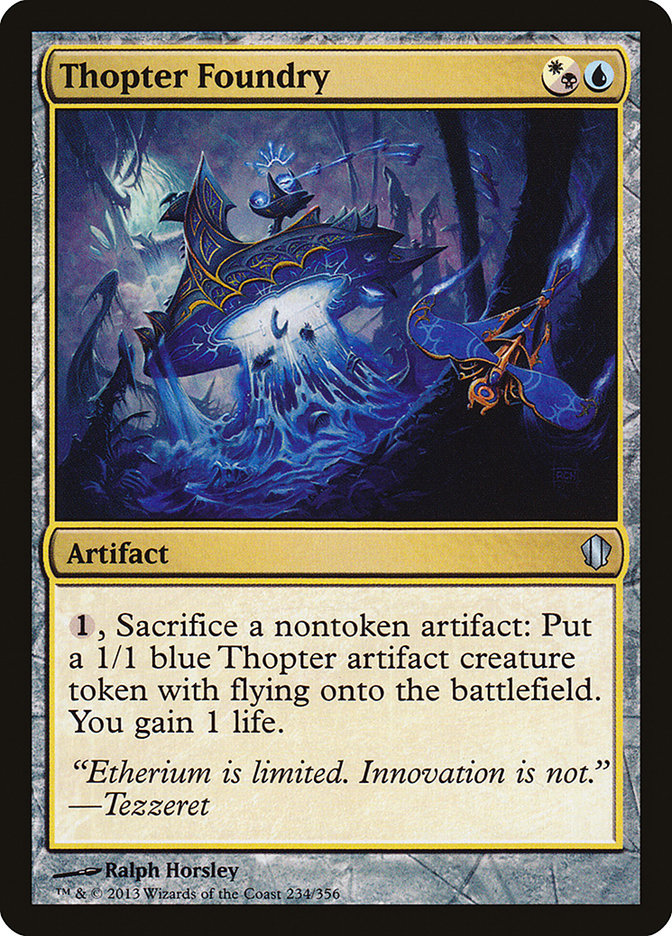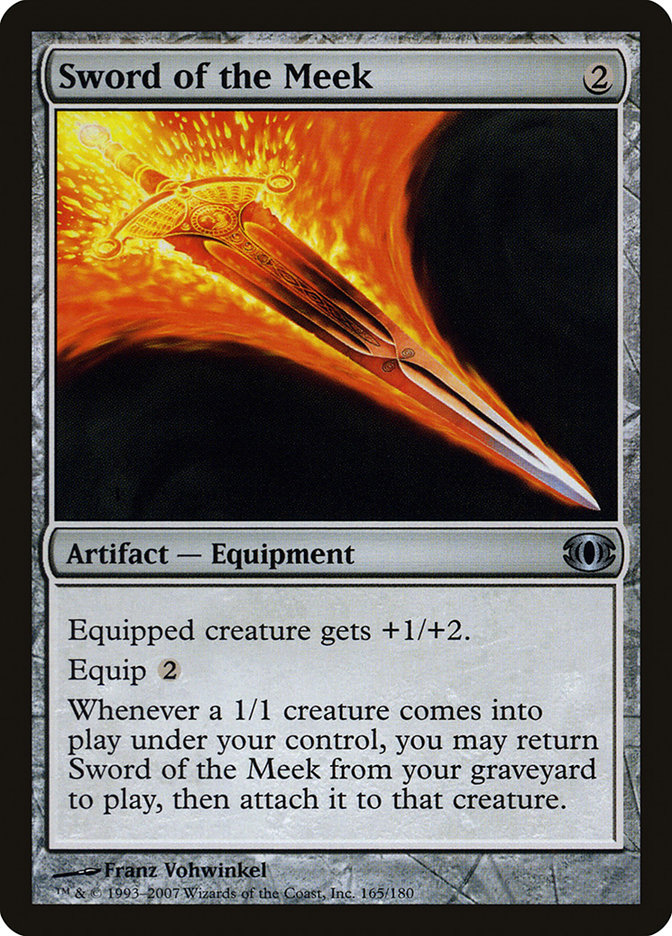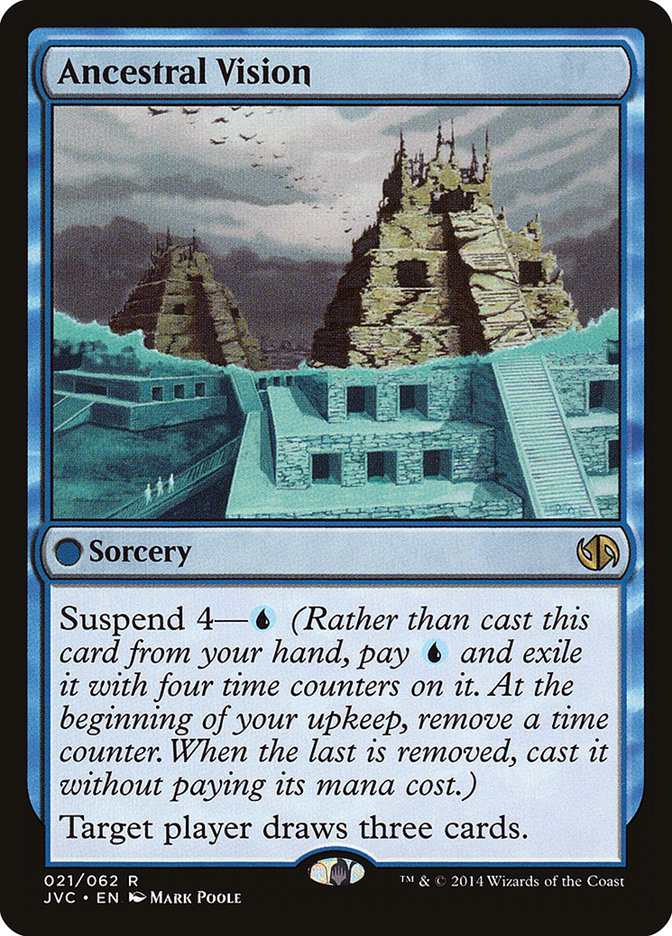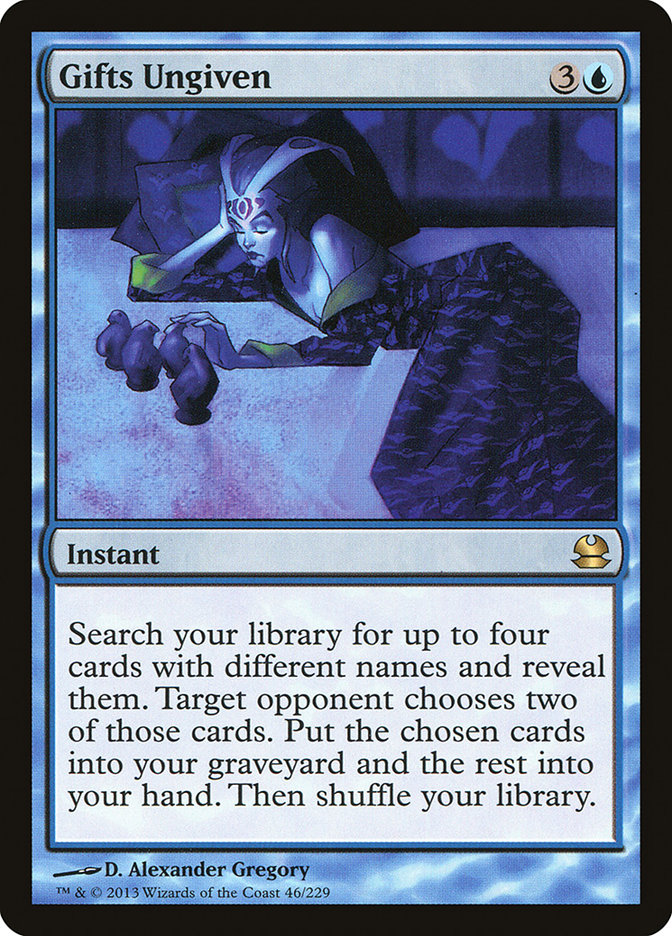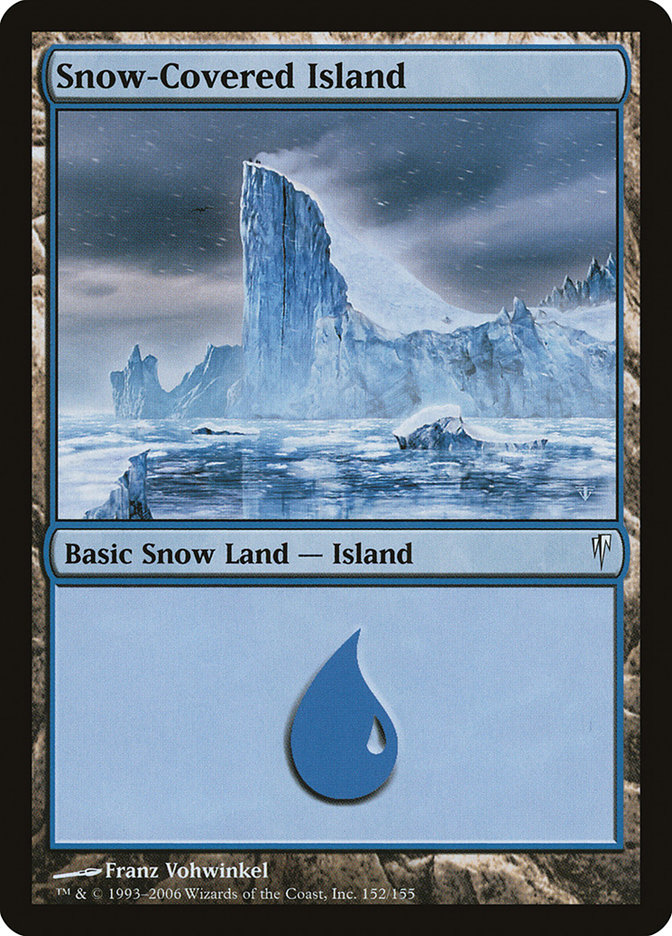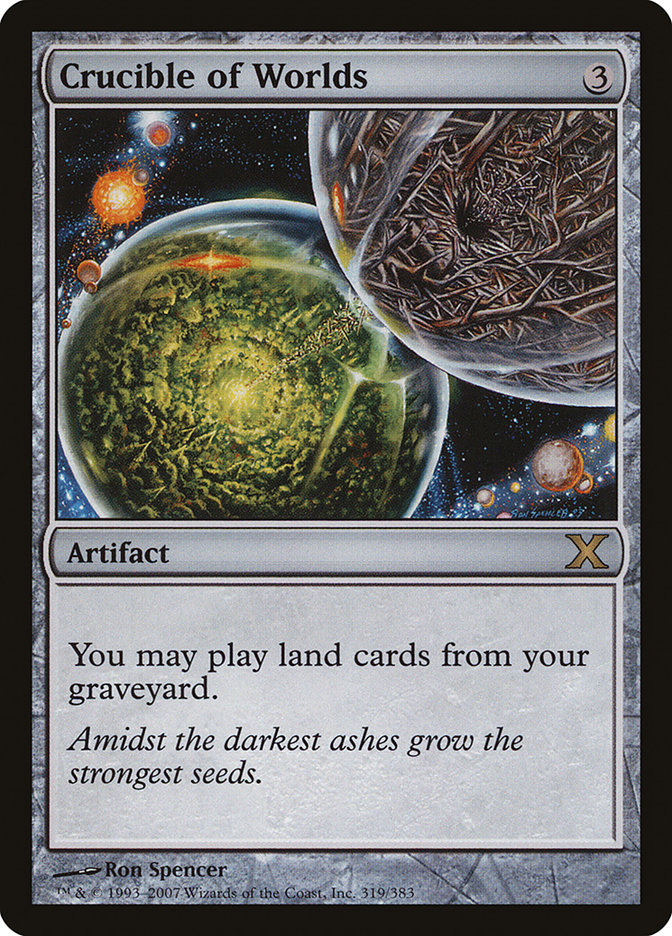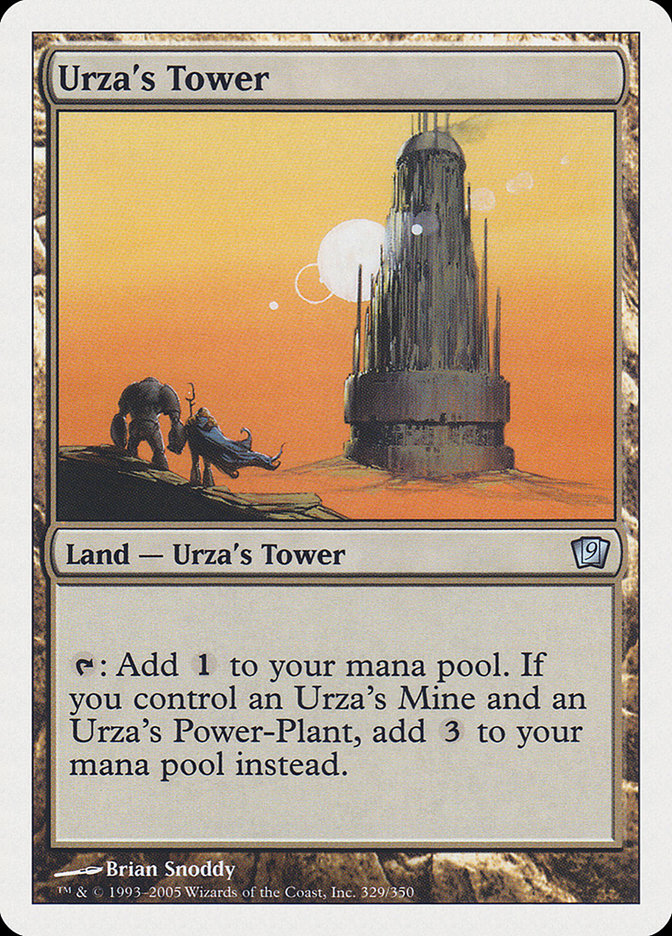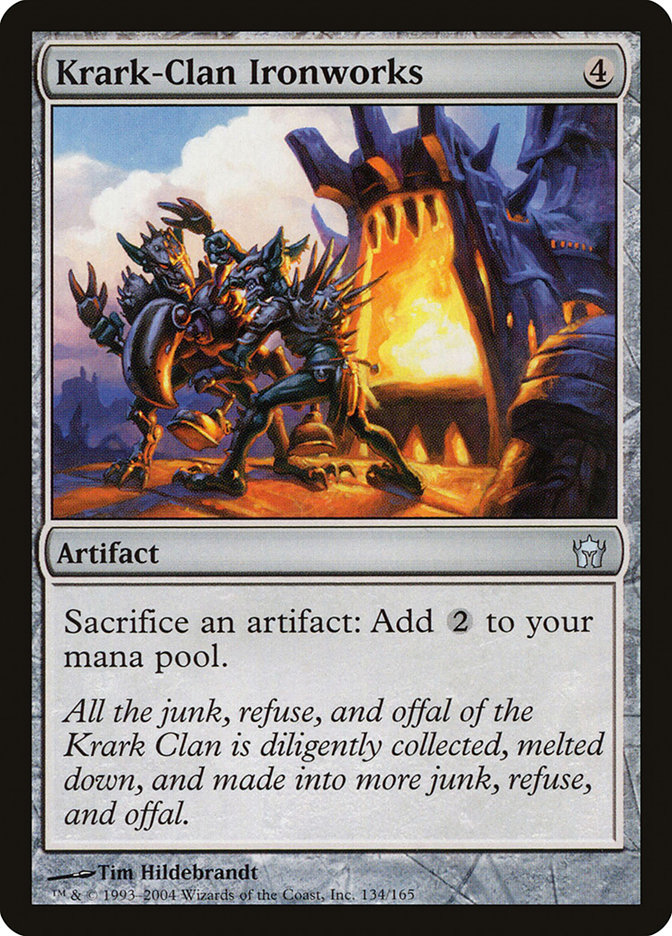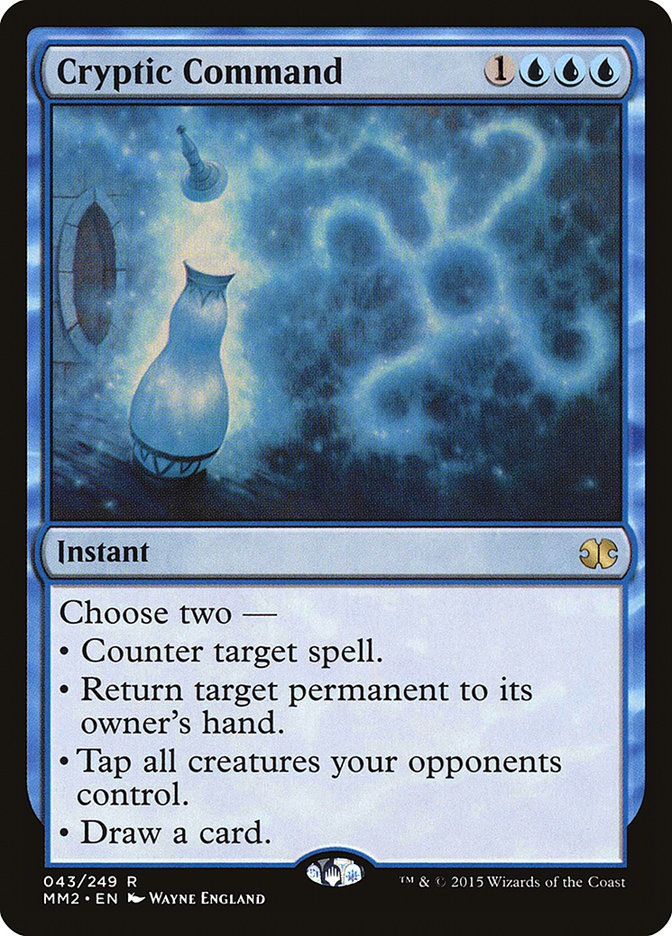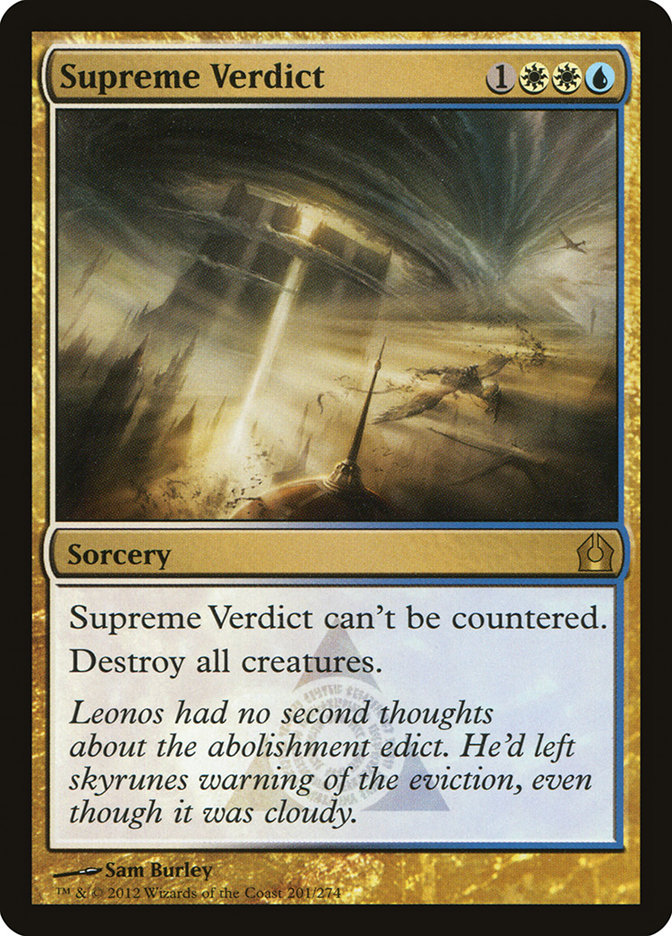Magic is weird.
Over nearly two decades, I’ve picked up plenty of knowledge. One might say I have a thirst for it. That’s the funny thing, though. Just because you have an abundance of knowledge doesn’t necessarily mean you have as much as you need or even the right kind.
“I have no idea how to build Modern decks,” I said out loud to no one in particular.
The seven Magic players who were currently hanging out in my hotel room, each very capable, did not want to help or offer advice. They knew better. Some had tried earlier, but I was not in the mood. This was something I needed to do on my own.
Over the last week, I had to re-learn everything I knew about Thopter Foundry / Sword of the Meek and try to apply it to current Modern. The B&R announcement was earth-shattering, and despite being confident in my Standard deck, I found myself barely limping into Day 2 of the Standard Open at #SCGBALT at 6-3. In order to have the best chance of making it to the Players’ Championship, I decided to drop from the Open and join the Modern Classic instead.
In front of me was a pile of assorted Modern cards that could potentially fit into a Thopter Foundry deck. Like a freshly opened puzzle, I could see all the pieces but couldn’t see where they fit together. Given my history with similar decks, I was disappointed in myself for not immediately seeing how everything worked in tandem with each other.
It’s that moment where you start to fully understand your own limitations.
I was frustrated.
I kept tinkering and finally had something. It wasn’t that “aha!” moment where you just know you have it all figured out, but it was better than what I had previously. While I was worried that I should just stay in the Standard Open, I registered it anyway.
And I think I made the right choice.
Creatures (2)
Lands (23)
Spells (35)

Let’s start from the beginning.
What Is This Deck?
Sword of the Meek was recently unbanned. Together with Thopter Foundry, you gain a hero power of “1: Put a 1/1 blue Thopter artifact creature token with flying onto the battlefield. Move Sword of the Meek in and out of various zones. You gain one life.”
Your game-plan is to control the early-game and eventually set up that “combo.” I use quotation marks because, despite it being a two-card combo, it doesn’t end the game on the spot. However, it does give you a certain amount of inevitability. Note that you yourself do not have inevitability without the combo. Everything you do should work toward assembling it, because without it, you will eventually die to even the most meager beats.
Sword of the Meek was banned because it was deemed too powerful. The combo often locked out combat steps, put players out of burn range, and was difficult to break up. While you didn’t win the game on the spot, you often won several turns later. Meanwhile, your opponent was struggling to play this game where you gained ten life and they could no longer attack.
People would often sideboard in artifact destruction in an attempt to deal with the combo, but the Thopter Foundry / Sword of the Meek player would shave on combo pieces, become more controlling, and assemble an unbreakable combo after they stabilized thanks to Academy Ruins.
It was frustrating.
You Played the Wrong Vision(s)!
Did I?
My first inclination was to build a Grixis Control shell with Ancestral Vision and Thopter Foundry. After sketching out some decklists, it was pretty clear that what I had wasn’t going to work. For starters, Snapcaster Mage (and Jace, Vryn’s Prodigy) didn’t fit well in a deck that didn’t have many spells that could be flashed back. Kolaghan’s Command is the main draw to Grixis, and is next to useless in the deck without any creatures to return.
So, U/B then? Nope. The black removal is lacking compared to red and white and your sideboard cards are weak.
I also didn’t want to play Ancestral Vision alongside discard spells, despite that combination being potent in Shardless Sultai. In Legacy, you need the discard to ensure you don’t get killed by combo decks in the early turns, and discard is typically live against other blue decks thanks to their Brainstorms, even if the game goes relatively long.
When my Ancestral Vision comes off, I want to draw business. In order for a hard-card drawer to be good, your cards have to be worth the effort you’re putting in, which is either spending mana or, in Ancestral Vision’s case, time.
If your Ancestral Vision resolves and you draw Unburial Rites, seven of clubs, 1989 Upper Deck Ken Griffey Jr. rookie card, and an Island, what have you really accomplished?
This was a big breakthrough. In the Jeskai version, I would often resolve an Ancestral Vision, draw some bricks, and eventually run out of velocity. Both Gifts Ungiven and Serum Visions came to mind. Once I got over the fact that the card I wanted to play wasn’t a good option for my deck, things kind of fell into place.
Ari Lax kind of nailed it.
With Ancestral Vision not fitting into any deck that has Thopter Foundry and Sword of the Meek, that left me with Thirst for Knowledge, Gifts Ungiven, Serum Visions, and Muddle the Mixture to help me find what I need. I could have used hard card drawing to assemble my combo, but the filtering helps you see more cards sooner. Since I was trying to assemble a two-card combo rather than a critical mass of cards, the filtering made more sense.
Why So Many Combo Pieces?
The easiest games are when you play turn 2 Sword of the Meek and turn 3 Thopter Foundry and make a token. Similarly, the combo is much better when you naturally draw it instead of having to search for it with Gifts Ungiven or Muddle the Mixture. Those cards cost mana and don’t affect the battlefield, so each time you use them, you’re falling farther behind. While they provide some resiliency and consistency, you’d prefer to not use them if you didn’t have to.
Running three Thopter Foundry and two Sword of the Meek in a dedicated control shell is not enough pieces unless you also have ways to search for them like Muddle the Mixture or Gifts Ungiven. You might have a piece here or there but will rarely assemble the combo early enough to be worth it.
At that point, you should either be playing an inevitability-based deck that finds the combo with one card (Gifts Ungiven), a tempo-ish control deck that turns the corner quickly (such as Jeskai Control with Snapcaster Mage and Restoration Angel), or just play a bunch of Thopter Foundry pieces so you can have the combo early and often.
If you want to play the Thopter Foundry / Sword of the Meek combo correctly, you’ll likely want to play more pieces. They enable your best draws, they make Thirst for Knowledge playable, and they draw your opponent’s focus onto something that isn’t going to be as important in the post-sideboard games.
Think about the various Tron decks out there, and specifically how scary they are when they have natural Tron on turn 3. You play more pieces to accomplish that because those are your best draws. Sure, your pieces might have diminishing returns, but sometimes someone tries to blow them up anyway.
Either way, naturally drawing them is typically better than having to tutor them up.
How Do You Beat the Hate? Is the Deck as Soft to Hate as It Seems?
Sidestepping hate with a transformational sideboard or playing cards that incidentally beat the hate are my preferred methods of defeating something like Stony Silence. For example, I have Unburial Rites for Elesh Norn, Grand Cenobite maindeck and Elspeth, Sun’s Champion in the sideboard, plus I’ll sideboard out some of the artifacts in anticipation of Stony Silence coming in. Oblivion Ring and Detention Sphere can also be used to remove a Stony Silence if necessary.
Using my sideboard to counteract their sideboard is one of my favorite things to do in Magic, and it’s my favorite thing about playing with Thopter Foundry and Sword of the Meek. Once you beat them with it, they overvalue it and don’t want to lose to it again. Make your deck be about something else as flawlessly as you can, and make their sideboard cards worthless. They will likely keep loose hands that contain their sideboard cards and mulligan reasonable hands that don’t have any.
Abuse that.
While Elspeth, Sun’s Champion is a trump out of the sideboard, I did have concerns about what type of maindeck hate I’d face. Whenever someone suggested unbanning Sword of the Meek because Abrupt Decay and Kolaghan’s Commands were a thing, I’d remind them that not every deck played black. Most other decks don’t have that type of incidental artifact destruction, and that was very clear during the tournament. Many of my opponents folded to the combo in Game 1.
If they did have access to those cards, it meant their deck was a little slower, and they would probably lose to Academy Ruins eventually.
I’m not scared of any sort of hate card (although Leyline of the Void / Rest in Peace do stop two of my angles). What I’m really scared of is a clock plus disruption.
Why Is Your Deck So Bad Against Combo and Tron?
Because that’s how I built my deck. I made a hard read on the metagame that those decks would not be prevalent and I was correct. You can’t beat everything, so I tried to beat the decks I thought would actually be in the tournament.
Playing several pieces of blank cardboard in your maindeck (Elesh Norn, Grand Cenobite; Iona, Shield of Emeria; Unburial Rites; Sword of the Meek) will lead to a lot of disjointed draws. You can mitigate that by playing cards that filter through rapidly, such as Thirst for Knowledge, but ultimately the best way to mitigate those risks is by playing fewer bad cards.
Since I didn’t expect combo, I moved the Iona, Shield of Emeria to the sideboard and it was perfect.
What I Did Right
Typically, decks similar to these play Azorius Signet. However, that’s generally associated with the Urza’s lands, where you can turn a colorless mana into two colored mana. In a deck with a bunch of one-drops, Talisman of Progress is superior, despite dealing damage on occasion. Being able to play a one-mana spell off your two-drop accelerator is excellent, especially if it’s Spell Snare or Path to Exile. Azorius Signet would have been better when I had a few colorless lands and was trying to cast Supreme Verdict, but that was about it.
So, even if Talisman of Progress is better than Azorius Signet, why play either at all? Does this deck need the mana acceleration?
Questions like that are why deckbuilding intrigues me. On the surface, Talisman of Progress is a simple mana accelerator, but it’s actually so much more than that. The most important part about Talisman of Progress’s inclusion is that it’s an artifact. I searched for playable artifacts to include not only for Thirst for Knowledge but also for Thopter Foundry.
When you’re playing with the Thopter Foundry / Sword of the Meek combo, there are many situations in which you’ll finally find Thopter Foundry, but Sword of the Meek is in your graveyard thanks to Thirst for Knowledge or Gifts Ungiven. In those spots, having any artifact to sacrifice to Thopter Foundry will jump-start your engine. A 1/1 creature entering the battlefield will also do it.
The old decks got to play with Seat of the Synod and Ancient Den, but we have no such luxury (unless we want to play Darksteel Citadel, which I don’t). Since we don’t have access to any artifacts that we get to add to our deck for free, we have to look elsewhere.
Talisman of Progress and Engineered Explosives are reasonable additions to the deck already, and ten artifacts felt like a safe place to be.
The best card in my deck might surprise you, but it was Muddle the Mixture. At first, I was worried about being light on countermagic, but Muddle the Mixture always had a powerful target to counter. If it was useless or I had too many, I would start transmuting.
While the games weren’t particularly slow, but they weren’t blistering fast either. My deck did its job of staying alive, and Muddle the Mixture was there to find the missing pieces for me. Of course, it’s still better to naturally draw the pieces than have to tutor for them, but Muddle was there to tie it all together.
It’s possible that my Muddle the Mixture toolbox could be improved. When I played Dark Depths, I had either a Doom Blade, Echoing Truth, or Boomerang to tutor for in case I really needed to remove a permanent. In this deck, I had a Snapcaster Mage that I assumed would have a Path to Exile or sweeper, but that didn’t come up often.
Tutoring for Mind Spring against Jund in the post-sideboard games was something I heavily considered.
Many people have commented on how Gifts Ungiven is too slow for Modern and always has been, so why is it playable now?
I suppose my answer is that Gifts Ungiven isn’t any slower than any other four-drop that sees play in Modern, and that whether or not any four-drop is playable is dependent on what’s important in the games you’re playing and how well that four-drop translates into you winning games.
Surviving to cast a four-mana spell in Modern is kind of a feat in itself, so naturally those spells have a certain amount of importance placed on them. With Pia and Kiran Nalaar, you get to stabilize the battlefield almost immediately, plus you have a threat split up between three bodies if the matchup is about spot removal. With Gifts Ungiven, you’re not affecting the battlefield, so either you need the matchups you’re going to play against to not be about that, or you’re going to need Gifts Ungiven to catch you back up in a hurry.
Thankfully, if any card can do that, Gifts Ungiven can.
Obviously Snapcaster Mage is great, but with artifacts and expensive spells taking up a large portion of my deck, I didn’t want access to too many Snapcaster Mages. I could envision many situations where my graveyard was devoid of cheap spells. Plus, I can’t use the 2/1 body, so while Snapcaster Mage is excellent as a split card, it was mostly useless for me outside of Gifts Ungiven piles.
Too cute.
You will never use Gifts Ungiven and “need” to search for multiple basics. It may be technically correct, because you might as well give yourself the option, but it’s far more likely that your opponent sees a Snow-Covered land and knows what you’re up to.
Instead of Crucible of Worlds, I played Tolaria West and a second Academy Ruins. You can use either package to guarantee assembling the combo, but Tolaria West and Academy Ruins are better natural draws, at least in my opinion. There certainly exists a world in which Crucible of Worlds and Ghost Quarter does nasty things to people, but if G/R Tron is big, I wouldn’t play this U/W deck in the first place.
Remember some of those issues I brought up earlier, like not having playable artifacts or 1/1 creatures to return a Sword of the Meek? Well, Trinket Mage fixes those problems to some degree. You could even Trinket Mage for Hangarback Walker and have the best of both worlds.
That said, Trinket Mage is more of the “spend mana to accomplish very little,” and I think we’ve filled our quota on that. With Talisman of Progress and Engineered Explosives, I think I solved whatever issues there were.
Why didn’t I just play U/W Tron? I considered it, especially since the deck I landed on is so similar to U/W Tron, both in card choices, planning, and execution. The thing that U/W Tron does well is go over the top of people. The combo kind of does that, but most of the time, you don’t need the excess mana
Post-sideboard games are a real concern also. My deck has ten artifacts and I’d frequently shave on them after sideboarding. With U/W Tron, you can’t shave enough to make their Stony Silences worthless, so you end up opening yourself up to the hate that I’d rather avoid.
I started toying with a Crucible of Worlds + Haven of the Spirit Dragon + Ugin, the Spirit Dragon package in U/W Tron. That would definitely be good against all the random hate out there. The issue is that you likely won’t get to cast Ugin, the Spirit Dragon when your Expedition Maps and Azorius Signets are locked down under a Stony Silence.
The U/W Tron decks I sketched up didn’t make great use of their extra mana, so I decided to ditch the artifacts and colorless lands and roll with a small-ball version instead.
If you add a third piece to the combo, you can actually get infinite turns or infinite life and mana, depending on which way you want to go. We’re already playing Muddle the Mixture (and I want to add black mana), so Time Sieve is a consideration. I played it in my sideboard for a bit back in the day because I wanted to beat combo and the Thopter Foundry mirrors, and we could easily do that now.
As for Krark-Clan Ironworks, there’s no point. It’s slow and useless by itself. You might still lose after comboing.
What I Did Wrong
I could have used Cryptic Command. It’s a perfectly reasonable card and was in my original lists. Oftentimes, using Cryptic Command as a Fog with a cantrip does little in something like Grixis Control, as they have very few, if any, ways to come back from behind. However, in this deck, you could find the other part of the combo or a sweeper.
It’s a clunker and I wanted my deck to be a lean machine, so Cryptic Command got the axe. While I don’t think it’s a clear mistake to omit it, I imagine many people will play it going forward. Playing one copy is nearly free.
A black source was necessary, not just for Unburial Rites but mostly Engineered Explosives. That cost me at least a match and maybe two.
Using Gifts Ungiven to fetch three sweepers (Wrath of God, Day of Judgment, Supreme Verdict, X) never came up, and likely never will, despite playing against several creature decks. Most of the time, you will get Unburial Rites + Elesh Norn, Grand Cenobite in those spots. A two maindeck / one sideboard ratio of sweepers would have felt much better.
With the hype surrounding Thopter Foundry, I couldn’t imagine Affinity showing up in large numbers. Even if they did, they probably wouldn’t be able to survive the amount of splash damage. I could have used that as a cue to trim on Affinity hate.
My Hurkyl’s Recalls were useless. I kind of assumed they would be, but I also didn’t know how difficult the Affinity matchup would be, despite having sweepers, Ghost Quarters, and a horde of 1/1 fliers myself. After playing the deck, I don’t think the matchup will be terrible.
Is Sword of the Meek Too Good for Modern?
I didn’t win the tournament, so I’m sure most people will say no. However, my opponents did not typically win when I assembled my combo, nor did they seem very pleased about what the games were about once it occurred. It made me feel like the bad guy. Not like I was playing Jund or Affinity or Twin or whatever the enemy of the week wa; it was like I was doing something that was and should be frowned upon.
So I guess I should run it back this weekend.


